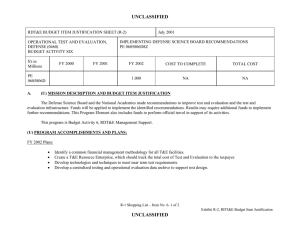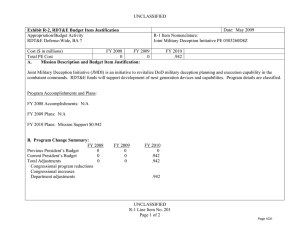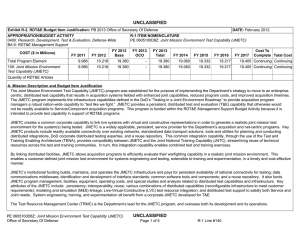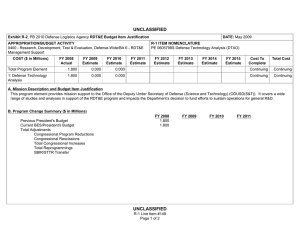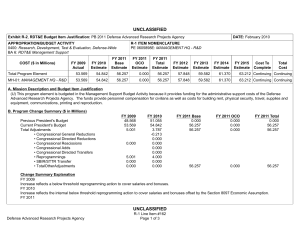UNCLASSIFIED
advertisement
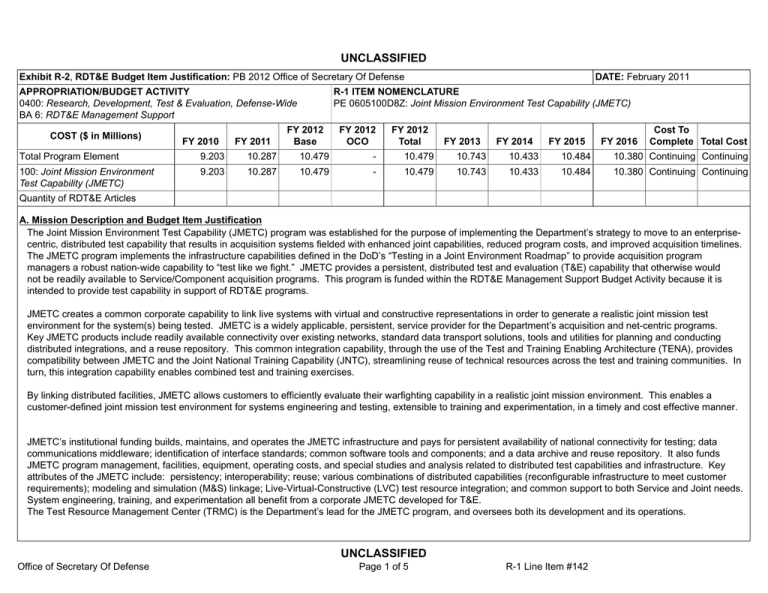
UNCLASSIFIED Exhibit R-2, RDT&E Budget Item Justification: PB 2012 Office of Secretary Of Defense APPROPRIATION/BUDGET ACTIVITY 0400: Research, Development, Test & Evaluation, Defense-Wide BA 6: RDT&E Management Support COST ($ in Millions) FY 2010 FY 2011 DATE: February 2011 R-1 ITEM NOMENCLATURE PE 0605100D8Z: Joint Mission Environment Test Capability (JMETC) FY 2012 Base FY 2012 OCO FY 2012 Total FY 2013 FY 2014 FY 2015 FY 2016 Cost To Complete Total Cost Total Program Element 9.203 10.287 10.479 - 10.479 10.743 10.433 10.484 10.380 Continuing Continuing 100: Joint Mission Environment Test Capability (JMETC) 9.203 10.287 10.479 - 10.479 10.743 10.433 10.484 10.380 Continuing Continuing Quantity of RDT&E Articles A. Mission Description and Budget Item Justification The Joint Mission Environment Test Capability (JMETC) program was established for the purpose of implementing the Department’s strategy to move to an enterprisecentric, distributed test capability that results in acquisition systems fielded with enhanced joint capabilities, reduced program costs, and improved acquisition timelines. The JMETC program implements the infrastructure capabilities defined in the DoD’s “Testing in a Joint Environment Roadmap” to provide acquisition program managers a robust nation-wide capability to “test like we fight.” JMETC provides a persistent, distributed test and evaluation (T&E) capability that otherwise would not be readily available to Service/Component acquisition programs. This program is funded within the RDT&E Management Support Budget Activity because it is intended to provide test capability in support of RDT&E programs. JMETC creates a common corporate capability to link live systems with virtual and constructive representations in order to generate a realistic joint mission test environment for the system(s) being tested. JMETC is a widely applicable, persistent, service provider for the Department’s acquisition and net-centric programs. Key JMETC products include readily available connectivity over existing networks, standard data transport solutions, tools and utilities for planning and conducting distributed integrations, and a reuse repository. This common integration capability, through the use of the Test and Training Enabling Architecture (TENA), provides compatibility between JMETC and the Joint National Training Capability (JNTC), streamlining reuse of technical resources across the test and training communities. In turn, this integration capability enables combined test and training exercises. By linking distributed facilities, JMETC allows customers to efficiently evaluate their warfighting capability in a realistic joint mission environment. This enables a customer-defined joint mission test environment for systems engineering and testing, extensible to training and experimentation, in a timely and cost effective manner. JMETC’s institutional funding builds, maintains, and operates the JMETC infrastructure and pays for persistent availability of national connectivity for testing; data communications middleware; identification of interface standards; common software tools and components; and a data archive and reuse repository. It also funds JMETC program management, facilities, equipment, operating costs, and special studies and analysis related to distributed test capabilities and infrastructure. Key attributes of the JMETC include: persistency; interoperability; reuse; various combinations of distributed capabilities (reconfigurable infrastructure to meet customer requirements); modeling and simulation (M&S) linkage; Live-Virtual-Constructive (LVC) test resource integration; and common support to both Service and Joint needs. System engineering, training, and experimentation all benefit from a corporate JMETC developed for T&E. The Test Resource Management Center (TRMC) is the Department’s lead for the JMETC program, and oversees both its development and its operations. Office of Secretary Of Defense UNCLASSIFIED Page 1 of 5 R-1 Line Item #142 UNCLASSIFIED Exhibit R-2, RDT&E Budget Item Justification: PB 2012 Office of Secretary Of Defense APPROPRIATION/BUDGET ACTIVITY 0400: Research, Development, Test & Evaluation, Defense-Wide BA 6: RDT&E Management Support B. Program Change Summary ($ in Millions) Previous President's Budget Current President's Budget Total Adjustments • Congressional General Reductions • Congressional Directed Reductions • Congressional Rescissions • Congressional Adds • Congressional Directed Transfers • Reprogrammings • SBIR/STTR Transfer • Other Program Adjustments • Economic Assumption Reductions DATE: February 2011 R-1 ITEM NOMENCLATURE PE 0605100D8Z: Joint Mission Environment Test Capability (JMETC) FY 2010 FY 2011 FY 2012 Base FY 2012 OCO FY 2012 Total 9.379 9.203 -0.176 10.287 10.287 - - - - - - - - - - 10.494 10.479 -0.015 - - - 10.494 10.479 -0.015 - -0.015 - - - -0.015 - - -0.162 -0.014 - C. Accomplishments/Planned Programs ($ in Millions) FY 2010 9.203 Title: Joint Mission Environment Test Capability FY 2010 Accomplishments: - Completed and disseminated a Department-wide study and report of identified issues, impacts, and improvement recommendations to the DoD Information Assurance Certification and Accreditation Process (DIACAP). - Completed the Joint Distributed Test Infrastructure Capabilities Based Assessment; the Study Brief and Recommendations were endorsed and accepted by the Net-Centric Functional Capabilities Board on July 9, 2010. The Test Resource Management Center was charged with implementing those recommendations. - Constructed the joint mission environment (utilizing live test resources interacting with virtual and constructive simulations) and successfully completed the test planning and test operations for the Joint Close Air Support (JCAS) Distributed Test in response to the US Joint Forces Command (USJFCOM) requirement for test data on the end-to-end timing of every segment of the warfighter’s call for close air support to verify and improve the JCAS Mission Thread developed by USJFCOM in coordination with the Services. - Continued upgrade of the Reuse Repository to provide general program information; provided lessons learned from previous events; stored software interfaces, tools, utilities, and test metadata; provided capabilities of each site on the JMETC infrastructure; provided all help desk functions; published the “best-of-breed” distributed test tools process; and provided opportunity for collaboration, making all available to the DoD T&E community for reuse. - Continued to provide distributed test infrastructure and support to acquisition programs and events as follows: Air Ground Integrated Layer Exploration (AGILE) Fire 10-2 and 10-3; B1-B Interoperability and Fully Integrated Data Link Testing; Battlefield Airborne Communications Node (BACN) Joint Urgent Operational Need (JUON) (Development Test/Operational Test (DT/ Office of Secretary Of Defense UNCLASSIFIED Page 2 of 5 R-1 Line Item #142 FY 2011 10.287 FY 2012 10.479 UNCLASSIFIED Exhibit R-2, RDT&E Budget Item Justification: PB 2012 Office of Secretary Of Defense APPROPRIATION/BUDGET ACTIVITY 0400: Research, Development, Test & Evaluation, Defense-Wide BA 6: RDT&E Management Support DATE: February 2011 R-1 ITEM NOMENCLATURE PE 0605100D8Z: Joint Mission Environment Test Capability (JMETC) C. Accomplishments/Planned Programs ($ in Millions) FY 2010 OT)); United Endeavor 10-1; Joint Integrated Air and Missile Defense Organization’s (JIAMDO) Joint Sensor Integration; Joint Expeditionary Forces Experiment (JEFX) 10-1, 10-2, and 10-3; JIAMDO's Correlation/Decorrelation Interoperability Test (C/ DIT) Integration Events; Broad Area Maritime Surveillance System (BAMS) Live, Virtual, Constructive (LVC) Distributed Event (DE) (Unmanned Aircraft Systems in a National Airspace); Joint Command, Control, Communications, Computers, Intelligence, Surveillance, and Reconnaissance (JC4ISR) Interoperability Test and Evaluation Capability (InterTEC) System Integration Test; Test and Training Enabling Architecture (TENA) Testing; and Joint Surface Warfare (JSuW) Joint Capability Technology Demonstration testing (four tests). - Continued collaboration with the Services to rationalize and consolidate distributed T&E services to the JMETC infrastructure. The Air Force Integrated Collaborative Environment (AF-ICE) has already completed the transition to the JMETC infrastructure. The Army has confirmed plans to transition distributed test services (e.g., Cross-Command Collaboration Effort, etc.) to the JMETC infrastructure and the coordination continues to transition the Navy’s Distributed Engineering Plant to the JMETC infrastructure. - Continued providing requirements analysis support to acquisition programs such as Small Diameter Bomb, Brigade Combat Team Modernization Program, Joint Integrated Air and Missile Defense’s Joint Track manager, and Multi-Mission Maritime Aircraft (MMA). - Continued to work with the JMETC Users Group to facilitate development and incorporation of the highest priority improvements to the distributed test software and standard interfaces to meet customer requirements. JMETC conducted three Users Group meetings in FY10 with an average of 245 participants from all DoD Components. Through the JMETC Users Group, the JMETC program office continued to assess and evaluate “best-of-breed” distributed test tools for application by the DoD T&E community. - Continued to expand the JMETC persistent connectivity infrastructure from 38 sites to 57 sites to meet customer requirements. - Continued conducting a technical watch for commercially available software tools to reinforce the current suite of JMETC standard distributed test support tools. - Continued outreach efforts to new acquisition programs that must demonstrate compliance with Net-Ready Key Performance Parameter requirements. - Continued planning support to on-going programs, particularly Joint Strike Fighter (JSF), MMA, Joint Tactical Radio System Airborne Maritime Fixed (JTRS-AMF), Gerald R. Ford Class (CVN-21), Multi-Function Advance Data Link (MADL), Army Brigade Combat Team Modernization Program, Navy Program Executive Office (PEO) for Integrated Warfare Systems (IWS), and InterTEC. - Initiated planning for the development of a JMETC mobile node to support transitory site distributed test needs. Office of Secretary Of Defense UNCLASSIFIED Page 3 of 5 R-1 Line Item #142 FY 2011 FY 2012 UNCLASSIFIED Exhibit R-2, RDT&E Budget Item Justification: PB 2012 Office of Secretary Of Defense APPROPRIATION/BUDGET ACTIVITY 0400: Research, Development, Test & Evaluation, Defense-Wide BA 6: RDT&E Management Support DATE: February 2011 R-1 ITEM NOMENCLATURE PE 0605100D8Z: Joint Mission Environment Test Capability (JMETC) C. Accomplishments/Planned Programs ($ in Millions) FY 2010 - Engaged/planned with more than 28 potential and active customers providing acquisition programs and test ranges with technical assistance on JMETC capabilities, standards, interfaces, tools, available nodes, and expertise in planning and conducting distributed tests. FY 2011 Plans: - Complete the concept development of a JMETC mobile node to support transitory site testing needs. - Continue to provide distributed test support for major customer events such as Joint Tactical Radio System (JTRS), JIAMDO Projects, Joint Interoperability Test Command's Joint Interoperability Tests (5 events), AGILE Fire (2 events), B-1B Fully Integrated Data Link Testing, BAMS LVC DE, Terminal Fury, BACN JUON, and Austere Challenge. - Continue to provide general distributed test support to customers such as Joint Strike Fighter M&S Interoperability, F-22 Data Link Testing, BAMS, Army Brigade Combat Team Modernization Program, MMA, CVN-21, JEFX, BACN JUON, Air Force Special Operations Command, and InterTEC Spiral 3, and for 3-10 smaller test activities. Assist and support customers with distributed test tools and expertise for planning their distributed events. - Continue outreach efforts to new acquisition programs that must demonstrate compliance with Net-Ready Key Performance Parameter requirements. - Continue planning support to on-going acquisition programs, particularly CVN-78, Army Brigade Team Modernization Program, JSF, and InterTEC. - Continue to provide distributed test planning support to other customers for their distributed test events. - Continue to support and upgrade the JMETC Reuse Repository to store software interfaces, tools, utilities, and test metadata making all available to the DoD test community for reuse. - Continue to expand and sustain the JMETC persistent connectivity infrastructure to some 63 sites to meet customer requirements in full consideration of maximizing their potential for reuse. Continue coordination with the High Performance Computing Modernization Office (HPCMO) to develop plans to improve network services focused on the Secure Defense Research and Engineering Network (SDREN) as well as implement an operational computer network defense capability. - Continue coordination efforts to rationalize and integrate Service distributed T&E infrastructure to the JMETC infrastructure. - Continue development and implementation of the “best of breed” distributed test tools selection process in coordination with the JMETC Users Group and complete plans and resource requirements determinations to sustain the “selected” tools. - Work with the T&E Community to define joint requirements for data management in the distributed test capability. Work with other DoD and Service programs to fulfill these requirements. FY 2012 Plans: - Continue to provide distributed test support for 3-4 major customer events such as Army Brigade Combat Team Modernization, MMA, CVN-21, and InterTEC, and 3-10 smaller test activities. Assist customers with distributed test tools and expertise for planning their distributed events. Office of Secretary Of Defense UNCLASSIFIED Page 4 of 5 R-1 Line Item #142 FY 2011 FY 2012 UNCLASSIFIED Exhibit R-2, RDT&E Budget Item Justification: PB 2012 Office of Secretary Of Defense APPROPRIATION/BUDGET ACTIVITY 0400: Research, Development, Test & Evaluation, Defense-Wide BA 6: RDT&E Management Support DATE: February 2011 R-1 ITEM NOMENCLATURE PE 0605100D8Z: Joint Mission Environment Test Capability (JMETC) C. Accomplishments/Planned Programs ($ in Millions) FY 2010 FY 2011 FY 2012 - Continue outreach efforts to new acquisition programs that must demonstrate compliance with Net-Ready Key Performance Parameter requirements. - Continue planning support to on-going acquisition programs, particularly JTRS, JIAMDO Projects, F-22, BAMS, JEFX, CVN-21, Army Brigade Combat Team Modernization, JSF, and InterTEC. - Continue to provide distributed test planning support to other customers for their distributed test events. - Continue coordination efforts to rationalize and integrate Service distributed T&E infrastructure to the JMETC infrastructure. - Continue to support and upgrade the JMETC Reuse Repository to store software interfaces, tools, utilities, and test metadata making all available to the DoD test community for reuse. - Continue to sustain the JMETC persistent connectivity infrastructure and expand as necessary to meet customer requirements in full consideration of maximizing the potential for reuse. - Continue “best of breed” distributed test tools selection process in coordination with the JMETC Users Group and complete plans and resource requirements determinations to sustain the “selected” tools. - Continue to expand and sustain the JMETC persistent connectivity infrastructure to meet customer requirements in full consideration of maximizing the potential for reuse. Accomplishments/Planned Programs Subtotals 9.203 10.287 D. Other Program Funding Summary ($ in Millions) N/A E. Acquisition Strategy N/A F. Performance Metrics - Expansion of initial capability to support acquisition program test requirements, providing distributed capability to test systems and demonstrating required joint capability. - Successful use of integration software compatible with the JNTC and Joint Training infrastructure. - Number of test sites/locations that are reused to support distributed tests using the JMETC infrastructure. Office of Secretary Of Defense UNCLASSIFIED Page 5 of 5 R-1 Line Item #142 10.479
